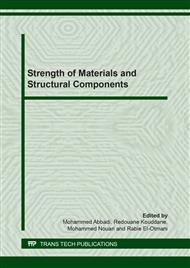p.9
p.18
p.29
p.40
p.48
p.60
p.75
p.85
p.97
Grain Shape Effect and the Viscoplastic Parameter on the Evolution of Isotropic and Kinematic Hardening of Metallic Materials under Cyclic Loading
Abstract:
The main objective of this work is to study the grain shape effect (aspect ratio α = a / b) and the viscoplastic parameter γ on the evolution of the kinematic and isotropic hardening of FCC type metallic materials, under uniaxial cyclic Tension-Compression ‘‘TC’ and to interpret these results. These parameters of shape and viscoplastic were developed and introduced by Abdul-Latif and Radi, indeed in this study we use their model. Expressed within the framework of a self-consistent approach, the rate-dependent inelastic strain is examined at the crystallographic slip system level describing a constitutive model for FCC metallic polycrystals, whereas the elastic strain is determined at the granular level. Based on the Eshelby’s tensor, the elastic behavior is assumed to be compressible. For a polycrystalline structure, the grains deform plastically by crystallographic slip located at the most favorably oriented systems supporting a high resolved shear stress . The approach considers that the inclusion (grain) form is ellipsoidal of half axes defining by a, b and c such as a ≠b= c. Several numerical tests are carried out highlighting the role of shape and viscoplastic parameter on the evolution of kinematic and isotropic hardening. A general comparison between the and effect on the overall hardening of the polycrystal shows that this work hardening is more sensitive to the parameter (for given ) compared to (for given). Keywords: Grain shape effect, Ellipsoidal inclusion, Viscoplastic parameter effect, Kinematic and isotropic hardening, Uniaxial cyclic ‘‘TC‘‘, Self-consistent model.
Info:
Periodical:
Pages:
48-59
Citation:
Online since:
September 2019
Price:
Сopyright:
© 2019 Trans Tech Publications Ltd. All Rights Reserved
Share:
Citation:


